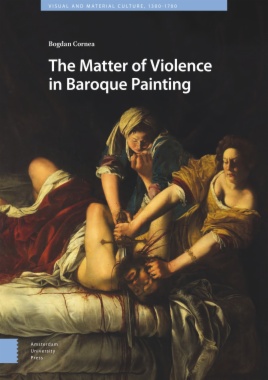Baroque depictions of violence are often dismissed as ‘over the top’ and ‘excessive’. Their material richness and exciting visual complexity, together with the visceral engagement they demand from beholders, are usually explained in literature as reflecting the presumed violence of early modern society. This book explores the intersection between materiality, excess, and violence in seventeenth-century paintings through a close analysis of some of the most iconic works of the period. Baroque paintings expose or reference their materiality by insisting on various physical changes wrought through violence. This study approaches violence as the work of materiality, which has the potential to analogously stage pictorial surfaces as corporeal surfaces, where paint becomes flayed flesh, canvas threads ruptured skin, and red paint spilt blood.
- Cover
- Table of Contents
- Acknowledgments
- An Introduction
- 1. Wound: On Caravaggio’s Martyrdom of Saint Ursula
- 2. Touch: On Giovanni Lanfranco’s Saint Peter Healing Saint Agatha
- 3. Skin: On Jusepe de Ribera’s Martyrdom of Saint Bartholomew
- 4. Flesh: On Georges de La Tour’s Penitent Saint Jerome
- 5. Blood: On Artemisia Gentileschi’s Judith Slaying Holofernes
- 6. Death: On Francisco de Zurbarán’s The Martyrdom of Saint Serapion
- Conclusion
- General Bibliography
- Index
- List of Images
- Image 1. Jusepe de Ribera, Apollo Flaying Marsyas, 1637, oil on canvas, 202 × 255 cm, Musées Royaux des Beaux-Arts de Belgique, Brussels. Image Credit: Open Access.
- Image 2. Michelangelo Merisi da Caravaggio, The Martyrdom of Saint Ursula, 1610, oil on canvas, 143 × 180 cm, Palazzo Zevallos-Stigliano, Naples. Image Credit: Intesa Sanpaolo Collection.
- Image 3. Michelangelo Merisi da Caravaggio, The Martyrdom of Saint Ursula, 1610, oil on canvas, 143 × 180 cm, Palazzo Zevallos-Stigliano, Naples. Image Credit: Intesa Sanpaolo Collection. DETAIL.
- Image 4. Michelangelo Merisi da Caravaggio, Judith Beheading Holofernes, 1598, oil on canvas, 145 × 195 cm, Palazzo Barberini, Rome. Image Credit: Gallerie Nazionali di Arte Antica, Roma (MiC) – Bibliotheca Hertziana, Istituto Max Planck per la storia del
- Image 5. Michelangelo Merisi da Caravaggio, Incredulity of Saint Thomas, 1602, Sanssouci Palace, Potsdam. Image Credit: Stiftung Preußische Schlösser und Gärten Berlin-Brandenburg. Photographer: Hans Bach.
- Image 6. Giovanni Lanfranco, Saint Peter Healing Saint Agatha, 1613–1614, Galleria Nazionale, Parma. Image Credit: Licenced by Ministerio dei Beni e Delle Attivita Culturali – Complesso Monumentale della Pilotta-Galleria Nationale di Parma.
- Image 7. Giovanni Lanfranco, Saint Peter Healing Saint Agatha, 1613–1614, Galleria Nazionale, Parma. Image Credit: Licenced by Ministerio dei Beni e Delle Attivita Culturali – Complesso Monumentale della Pilotta-Galleria Nationale di Parma. DETAIL.
- Image 8. Jusepe de Ribera, Apollo and Marsyas, 1637, Museo e Real Bosco di Capodimonte, Naples. Image Credit: Direzione Regionale Musei della Campania.
- Image 9. Jusepe de Ribera, The Martyrdom of Saint Bartholomew, 1644, Museu Nacional d’Art de Catalunya, Barcelona. Image Credit: Museu Nacional d’Art de Catalunya, Barcelona.
- Image 10. Jusepe de Ribera, The Martyrdom of Saint Bartholomew, 1644, Museu Nacional d’Art de Catalunya, Barcelona. Image Credit: Museu Nacional d’Art de Catalunya, Barcelona. DETAIL.
- Image 11. Jusepe de Ribera, The Martyrdom of Saint Bartholomew, 1634, oil on canvas, 104 × 113 cm, The National Gallery of Art, Washington, DC. Image Credit: Courtesy National Gallery of Art, Washington, DC.
- Image 12. Georges de La Tour, Penitent Saint Jerome, 1630–1635, oil on canvas, 157 × 100 cm, Musée de Grenoble, Grenoble. Image Credit: Ville de Grenoble/Musée de Grenoble – J.L. Lacroix.
- Image 13. Georges de La Tour, Penitent Saint Jerome, 1630–1635, oil on canvas, 157 × 100 cm, Musée de Grenoble, Grenoble. Image Credit: Ville de Grenoble/Musée de Grenoble – J.L. Lacroix. DETAIL.
- Image 14. Titian Vecellio, Saint Jerome in the Wilderness, c. 1575, oil on canvas, 137 × 97 cm, Thyssen-Bornemisza Museum, Madrid. Image Credit: Museo Nacional Thyssen-Bornemisza, Madrid.
- Image 15. Rembrandt Harmenszoon van Rijn, Saint Bartholomew, 1661, oil on canvas, 86.7 × 75.6 cm, The J. Paul Getty Museum, Los Angeles, CA. Image Credit: Open Content.
- Image 16. Artemisia Gentileschi, Judith Slaying Holofernes, 1614–1629, oil on canvas, 146.5 × 108 cm, Galleria degli Uffizi, Florence. Image Credit: Gabinetto Fotografico delle Gallerie degli Uffizi.
- Image 17. Artemisia Gentileschi, Judith Slaying Holofernes, 1614–1629, oil on canvas, 146.5 × 108 cm, Galleria degli Uffizi, Florence. Image Credit: Gabinetto Fotografico delle Gallerie degli Uffizi. DETAIL.
- Image 18. Bernardo Cavallino, The Martyrdom of Saint Bartholomew, 1634, Museo e Real Bosco di Capodimonte, Naples. Image Credit: Direzione Regionale Musei della Campania.
- Image 19. Bernardo Cavallino, The Martyrdom of Saint Bartholomew, 1634, Museo e Real Bosco di Capodimonte, Naples. Image Credit: Direzione Regionale Musei della Campania. DETAIL.
- Image 20. Francisco de Zurbarán, The Martyrdom of Saint Serapion, 1628, oil on canvas, 120.2 × 104 cm, Wadsworth Atheneum, Hartford. Image Credit: Allen Phillips\Wadsworth Atheneum.
- Image 21. Francisco de Zurbarán, Christ on the Cross, 1627, oil on canvas, 290.3 × 165.5 cm, Art Institute of Chicago, Chicago. Image Credit: Robert A. Waller Memorial Fund.
- Image 22. Francisco de Zurbarán, Veil of Veronica, c. 1630, oil on canvas, 107.3 × 79.4 cm, Museum of Fine Arts, Houston. Image Credit: Sarah Campbell Blaffer Foundation, Houston.
- Image 23. Francisco de Zurbarán, Saint Francis of Assisi According to Pope Nicholas V’s Vision, c. 1640, oil on canvas, 180.5 × 110.5 cm, Museu Nacional d’Art de Catalunya, Barcelona. Image Credit: Museu Nacional d’Art de Catalunya, Barcelona, 2022.

